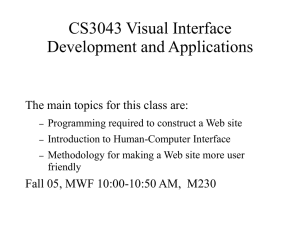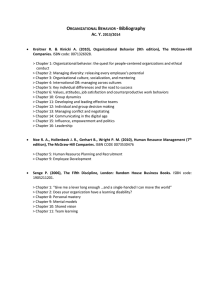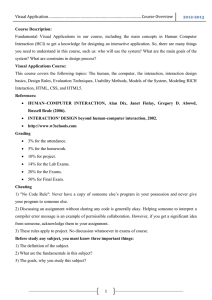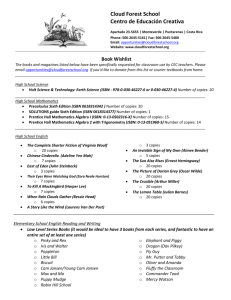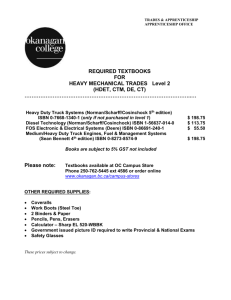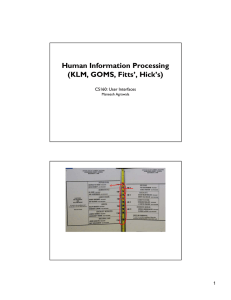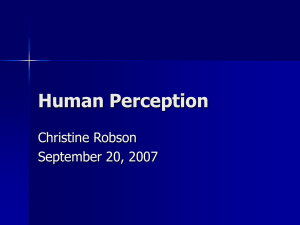Course_outline_CPIS_354_
advertisement
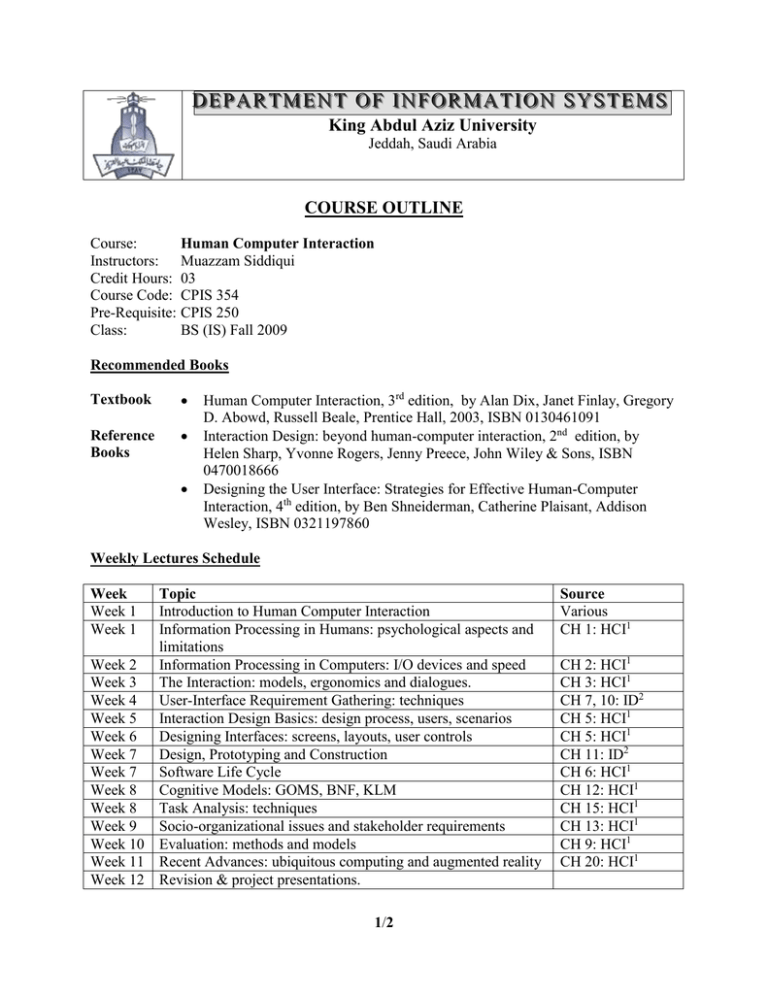
D DEEPPA AR RTTM MEEN NTT O OFF IIN NFFO OR RM MA ATTIIO ON N SSY YSSTTEEM MSS King Abdul Aziz University Jeddah, Saudi Arabia COURSE OUTLINE Course: Human Computer Interaction Instructors: Muazzam Siddiqui Credit Hours: 03 Course Code: CPIS 354 Pre-Requisite: CPIS 250 Class: BS (IS) Fall 2009 Recommended Books Textbook Reference Books Human Computer Interaction, 3rd edition, by Alan Dix, Janet Finlay, Gregory D. Abowd, Russell Beale, Prentice Hall, 2003, ISBN 0130461091 Interaction Design: beyond human-computer interaction, 2nd edition, by Helen Sharp, Yvonne Rogers, Jenny Preece, John Wiley & Sons, ISBN 0470018666 Designing the User Interface: Strategies for Effective Human-Computer Interaction, 4th edition, by Ben Shneiderman, Catherine Plaisant, Addison Wesley, ISBN 0321197860 Weekly Lectures Schedule Week Week 1 Week 1 Topic Introduction to Human Computer Interaction Information Processing in Humans: psychological aspects and limitations Week 2 Information Processing in Computers: I/O devices and speed Week 3 The Interaction: models, ergonomics and dialogues. Week 4 User-Interface Requirement Gathering: techniques Week 5 Interaction Design Basics: design process, users, scenarios Week 6 Designing Interfaces: screens, layouts, user controls Week 7 Design, Prototyping and Construction Week 7 Software Life Cycle Week 8 Cognitive Models: GOMS, BNF, KLM Week 8 Task Analysis: techniques Week 9 Socio-organizational issues and stakeholder requirements Week 10 Evaluation: methods and models Week 11 Recent Advances: ubiquitous computing and augmented reality Week 12 Revision & project presentations. 1/2 Source Various CH 1: HCI1 CH 2: HCI1 CH 3: HCI1 CH 7, 10: ID2 CH 5: HCI1 CH 5: HCI1 CH 11: ID2 CH 6: HCI1 CH 12: HCI1 CH 15: HCI1 CH 13: HCI1 CH 9: HCI1 CH 20: HCI1 1. HCI: Human Computer Interaction, 3rd edition, Alan Dix, Janet Finlay, Gregory D. Abowd, Russell Beale 2. ID: Interaction Design: beyond human-computer interaction, 2nd edition, Helen Sharp, Yvonne Rogers, Jenny Preece Assessment Type Percentage Assignments 10% Course Project 30% Midterm Exam 20% Final Exam 30% Lab 10% Course Aim This course introduces the students to the fundamentals of human computer interaction and how to build user-centered designs. Course Objective The objective of this course is to introduce the students to the concept of user centered designs. Students will understand the technical as well as psychological factors that affect the design of a user friendly interface. Syllabus Introduction to Human Computer Interaction Information Processing in Humans: psychological aspects and limitations Information Processing in Computers: I/O devices, memory Interaction between Humans and Computers: models, ergonomics and dialogues User-Interface Requirement Gathering: techniques, identifying needs and establishing requirements Interaction Design Basics: design process, users, scenarios Designing Interfaces: designing screens, layouts, user controls Design, Prototyping and Construction Software Life Cycle: HCI in the software process Cognitive Models: GOMS, BNF, KLM Task Analysis: techniques, sources of information, task analysis in design Socio-organizational issues and stakeholder requirements Evaluation: methods and models, usability, functionality and acceptability tests Recent advances: ubiquitous computing and augmented reality 2/2
